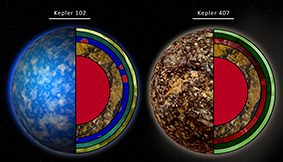Science Results
The Sloan Digital Sky Survey has been working for more than 20 years to make a map of the Universe, and will continue for many years to come. The video below shows a flythrough of the SDSS's map of the large-scale structure of the Universe.
But this map in itself is not the SDSS's real accomplishment; its real success is the revolutionary new knowledge that has been gained as a result. This page summarizes some of the major discoveries that the SDSS has enabled.
Results
Cosmology
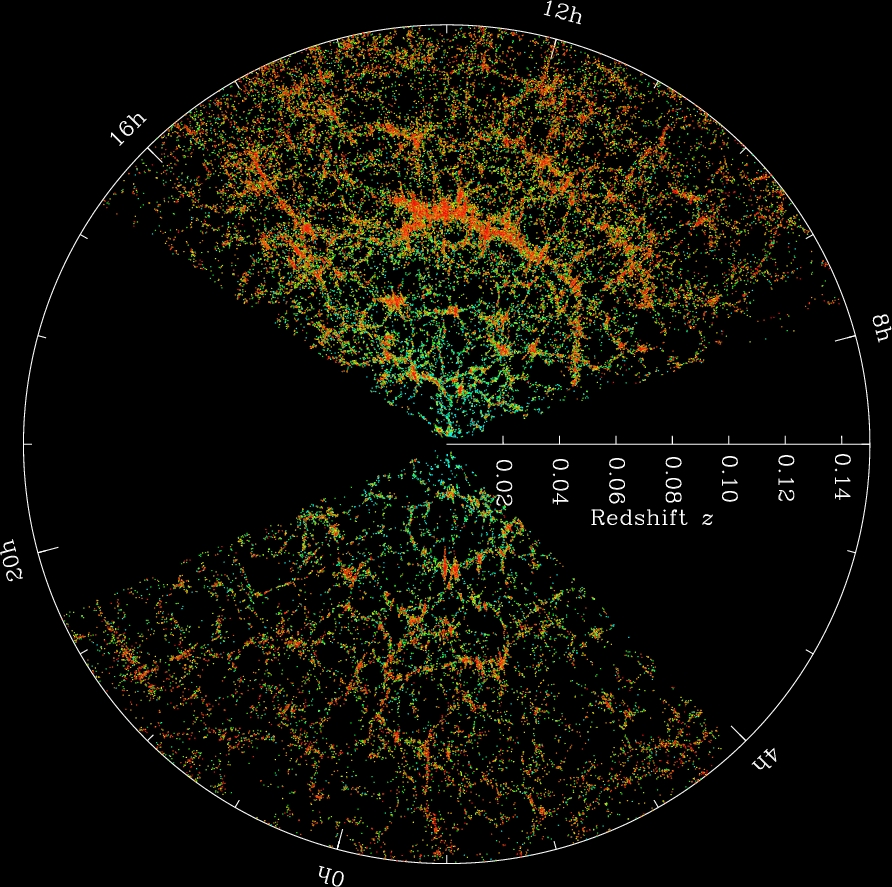
Measurements of large-scale structure in SDSS maps of galaxies, quasars, and intergalactic gas have become a central pillar of the standard cosmological model that describes our understanding of the history and future of the Universe. SDSS data have helped to demonstrate that the Universe is dominated by unseen dark matter and pervasive dark energy, and seeded with structure by quantum fluctuations in the infant cosmos. Those fluctuations have grown into the large-scale structure we see today.
The SDSS's high-precision maps of cosmic expansion history using baryon acoustic oscillations (BAOs) have been especially influential in quantifying these results, yielding exquisite constraints on the geometry and energy content of the universe. BAOs were first detected in galaxy clustering by the SDSS-I and in the contemporaneous 2dF Galaxy Redshift Survey. Since then, SDSS researchers have measured the BAOs an unprecedented one-percent precision, using measurements of more than one million galaxies — and for the first time, in the distribution of quasars. The SDSS was also the first survey to detect BAOs in intergalactic hydrogen gas using Lyman-alpha forest techniques, and has continued to improve these measurements as well.
These BAO measurements are beautifully complemented by the results of the SDSS-II Supernova Survey, which has provided the most precise measurements yet of cosmic expansion rates over the last four billion years. In addition, statistical measurements of galaxy motions and weak gravitational lensing provide some of the strongest evidence to date that Einstein's General Relativity is an accurate description of gravity on cosmological scales.
Quasars
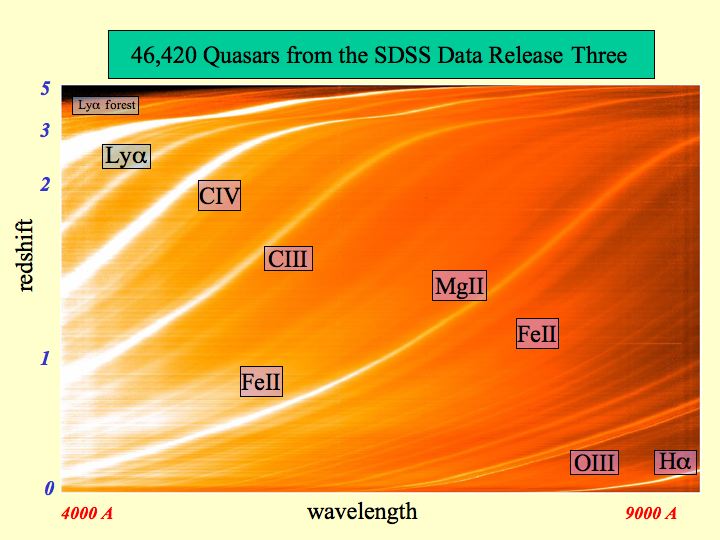
Credit: X. Fan and the Sloan Digital Sky Survey.
Powered by the accretion of gas onto supermassive black holes at the centers of galaxies, quasars are the most luminous objects in the Universe. With discoveries from its earliest imaging campaigns, the SDSS extended the study of quasars back to the first billion years after the Big Bang, showing the rapid early growth of black holes and mapping the end stages of the epoch of reionization.
With full quasar samples hundreds of times larger than those that existed before, the SDSS has given us the most accurate descriptions of the growth of black holes over cosmic history. SDSS spectra show that the properties of quasars have changed remarkably little from the early universe to the present day.
SDSS studies have probed the dark matter environments of quasars through clustering measurements, revealed populations of quasars whose central engines are hidden by obscuring dust, captured changes in quasar spectra that show clouds moving in the gravitational grip of the central black hole, and allowed a comprehensive census of the much fainter accreting black holes (active galactic nuclei, or AGN) in present-day galaxies.
By seeing so many quasars, the SDSS has been able to find examples of entirely new types of quasars. These new discoveries include quasars whose winds change drastically over just a few years, and galaxies whose central quasars sometimes almost completely disappear. A particularly unexpected and famous discovery was Hanny's Voorwerp — discovered by a primary school teacher as part of the Galaxy Zoo citizen science project — that turned out to be light reflected from a quasar that died more than 200,000 years ago.
Galaxies
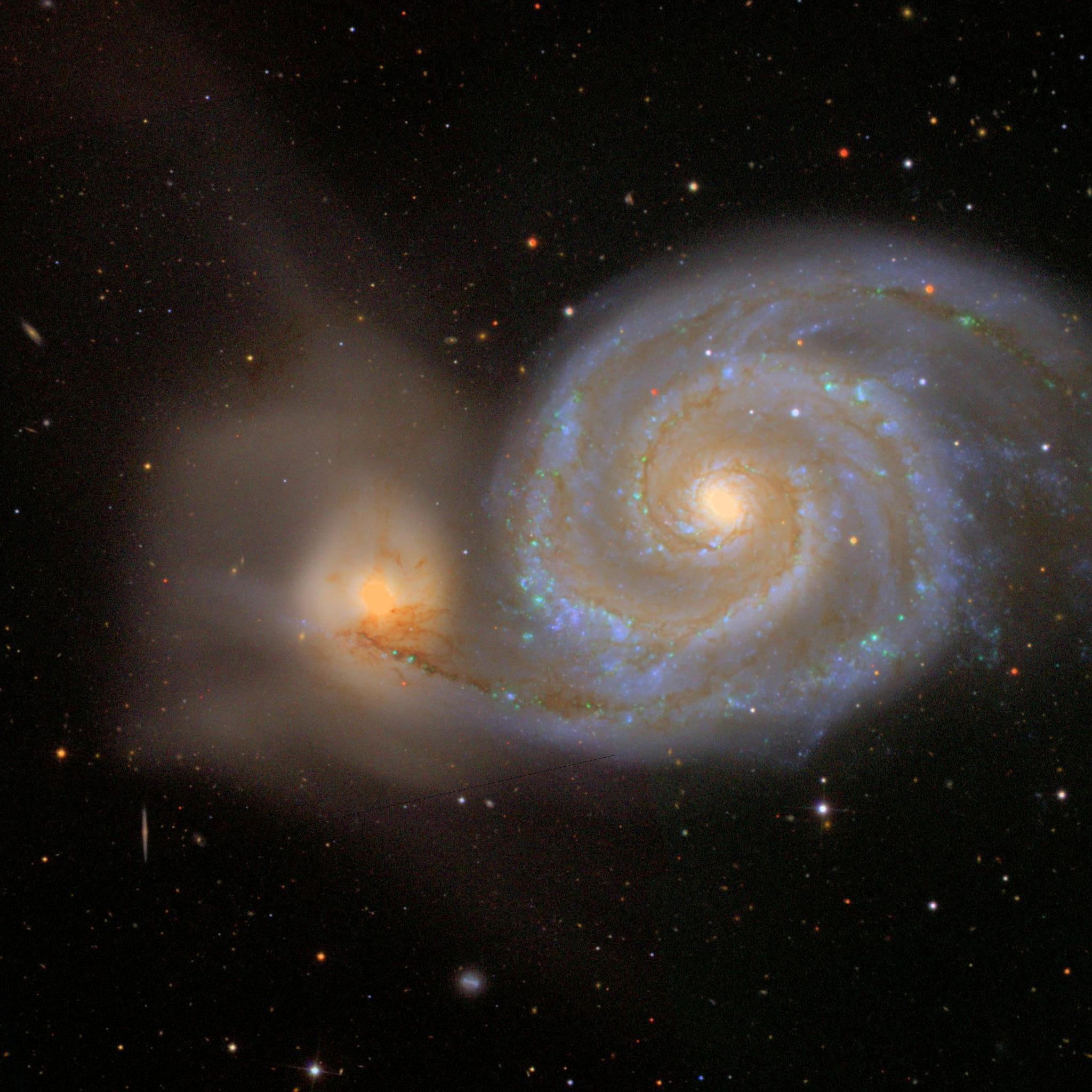
The SDSS has transformed the field of systematic galaxy analysis with accurate measurements of hundreds of parameters for hundreds of thousands of galaxies across the full range of cosmic environments. SDSS studies have demonstrated a bimodal distribution of galaxy properties, with a clear separation between populations of star-forming galaxies like the Milky Way, and passive galaxies that have little or no ongoing star formation.
Using weak gravitational lensing and statistical analyses of galaxy clustering, the SDSS has mapped out the multi-faceted relationships between galaxies and their surrounding halos of dark matter, showing that passive galaxies are found mainly at the centers of massive halos or as satellites orbiting larger galaxies.
Today, the SDSS's Mapping Nearby Galaxies at Apache Point Observatory (MaNGA) survey is studying the detailed structure of thousands of nearby galaxies for clues about the origin and evolution of galaxies. These observations have been used to solve a long-standing mystery about white dwarfs in galaxy centers, and to learn why galaxies stop making new stars.
The comprehensive census of present-day galaxies near and far from the SDSS provides an essential testing ground for theoretical models of galaxy formation. These studies have provided new insights into the ionization sources of gas in galaxy centers, and also into what circumstances might cause galaxies stop making new stars.
SDSS imaging enabled the discovery of a new population of "ultra-faint" dwarf galaxies orbiting the Milky Way. To date, the majority of known Milky Way companions have been found by the SDSS, along with several new companions of the Andromeda galaxy. With total light output as low as a thousand times the luminosity of the Sun, these tiny systems provide critical insights into the physics of galaxy formation and stringent tests of the properties of dark matter.
The Milky Way
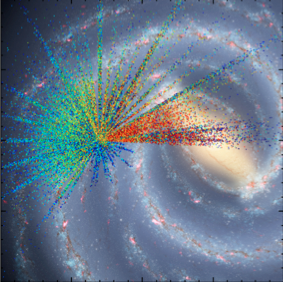
The SDSS is mapping the structure and chemical makeup of our Galaxy through its Apache Point Observatory Galaxy Evolution Experiment (APOGEE) surveys. With these observations and prior SDSS results, SDSS researchers measure the abundances of multiple elements in the periodic table found in each of hundreds of thousands of stars across the Galaxy.
This chemical cartography provides information about the formation and evolution of the Milky Way, because the chemistry of stars encodes information about the gas from which they formed, and this gas is enriched in different elements in a variety of astrophysical environments. APOGEE is particularly good at studying the stars in the flat disk of the Milky Way — which contains the vast majority of Milky Way stars — because it works in infrared light that is better able to penetrate the dust that is also found in the disk of the Milky Way. In addition, APOGEE takes advantage of another, identical spectrograph as a "second eye on the sky," located at the Irénée du Pont Telescope at Las Campanas Observatory in Chile. Having one spectrograph in each hemisphere allows the SDSS to simultaneously observe the entire Galaxy, both bulge and disk, from Earth's Northern and Southern Hemispheres.
The new picture of the Milky Way that the SDSS reveals shows a galaxy criss-crossed by long streams of stars, each associated with a former satellite galaxy that has since been absorbed into the Milky Way. By studying the distribution of these streams, astronomers can reconstruct the history of how our Galaxy evolved by absorbing smaller galaxies.
SDSS measurements of the motions of stars in the disk and stellar halo have yielded the most precise determinations of the mass distribution of the Milky Way's dark matter halo, implying a total halo mass of approximately one trillion solar masses, lower than many previous estimates.
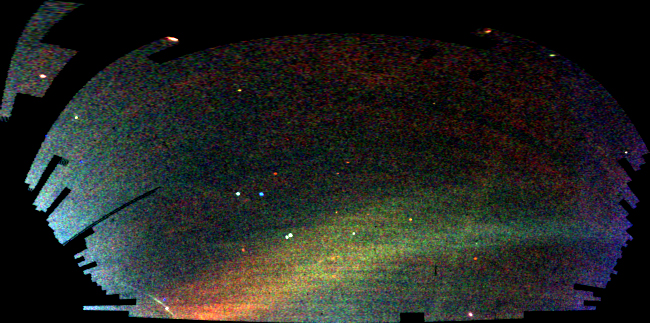
Stars

With precise multi-color imaging of hundreds of millions of stars, the SDSS has enabled systematic characterization of stellar populations and the identification of large samples of rare or intrinsically faint objects. Astronomers have used SDSS data to discover numerous brown dwarfs, objects that form like stars but are not massive enough to ignite steady hydrogen fusion at their centers.
SDSS catalogs have provided our most detailed understanding of the population of low mass stars, which are individually faint but collectively represent a large fraction of the Galaxy's stellar mass. SDSS catalogs of white dwarfs, the Earth-sized embers left behind by sun-like stars at the ends of their lives, have been especially influential, revealing many subtleties of white dwarf physics and identifying metal-enriched systems that appear to be accreting material from surrounding belts of asteroids.
The combination of APOGEE chemical abundance measurements with asteroseismological data from NASA's Kepler satellite is opening a new era of stellar astrophysics that can probe the interior structure of thousands of stars — and, for the first time, determine their ages.
With SDSS data, astronomers have seen "hypervelocity stars," which passed too close to our Galaxy's central black hole and are now moving so fast that they will escape from the Milky Way entirely. SDSS observations have also improved our understanding of many other types of stars, such as cepheid variables.
Extrasolar Planets
SDSS discoveries have helped improve our understanding of extrasolar planetary systems - especially about what types of stars can host what types of exoplanets. One study found a relationship between the composition of a star and the periods of its orbiting planets, while another used stellar composition and planetary models to draw conclusions about planetary interiors with implications for habitability.
APOGEE is now embarking on the first search for "hot Jupiters" orbiting around all types of stars, everywhere in our Galaxy.
Solar System
Asteroids can be identified in SDSS imaging because they change position during the course of an 8-minute exposure with the SDSS camera. The SDSS has identified and measured colors of more than 100,000 asteroids and other Solar System minor objects. The video to the left shows the orbits of many of the asteroids that the SDSS has discovered. SDSS asteroid measurements are available online through the SDSS Moving Object Catalog.
SDSS asteroid studies demonstrated a marked change in the size distribution of main belt asteroids at a diameter of about 5 km, implying fewer small asteroids than previously believed. They also showed that families of asteroids with distinct orbital properties also have distinctive colors, revealing the importance of "space weathering" that changes the surface appearance of asteroids over time. Dynamical families appear to be the result of collisions in the asteroid belt that produce cascades of smaller bodies, exposing fresh material that was previously the interior of a larger body.
Most SDSS asteroids are in the main belt between Mars and Jupiter, but repeat imaging has also enabled the SDSS to discover objects in the outer Solar System, near or beyond the orbit of Neptune. One of these, the remarkable object 2006 SQ 372, is on a highly eccentric orbit that takes it to a distance of 800 AU (800 times the Earth-Sun distance). Modeling suggests that it has been dynamically scattered from the inner zone of the Oort Cloud, a cloud of distant cometary bodies that is a remnant of the Solar System's formation.
Other Science Results
Press Releases
The newest SDSS press releases are available through the SDSS Press Releases page of this website.
Prior press releases from the SDSS-III (2008-2014) and SDSS Classic (2000-2008) can be found on their respective websites.
SDSS Science Blog
Publications
Publications produced within the SDSS-IV collaboration are can be found on the SDSS-IV publications page.

